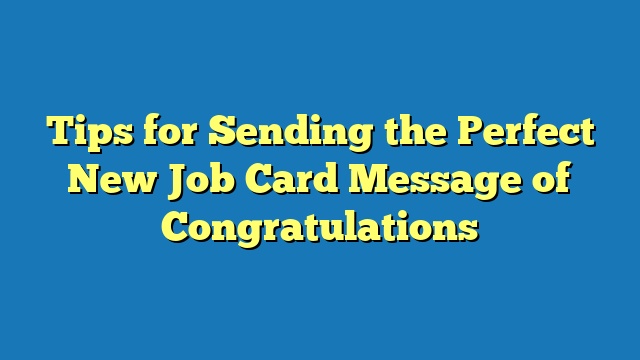A “new job card message” is a formal notification delivered to employees, typically upon hiring or a recent job change. It provides essential information about the employee’s new position, duties, and reporting structure. For instance, a new job card message for a software engineer might include details on their project responsibilities, team alignment, and expected start date.
New job card messages play a crucial role in onboarding employees. They help streamline the transition into the new role, ensuring a smooth and informed start. Benefits include enhanced communication, reduced onboarding time, increased employee satisfaction, and improved organizational efficiency. Historically, the concept of formal job card messages emerged with the rise of complex organizational structures and the need for clear communication during employee transitions.
This article delves into the significance of new job card messages and explores best practices for their effective implementation. We will discuss the essential elements, benefits, and challenges associated with this vital aspect of human resources management.
New Job Card Message
A well-crafted new job card message is essential for a smooth and successful onboarding process. It serves as a formal notification to employees, providing crucial information about their new role, responsibilities, and reporting structure. The key aspects of a new job card message encompass various dimensions, including:
- Clear and concise
- Accurate and up-to-date
- Professional and respectful
- Timely and efficient
- Informative and comprehensive
- Personalized and tailored
- Engaging and motivating
- Legally compliant
These key aspects are interconnected and contribute to the overall effectiveness of the new job card message. Clear and concise language ensures that the message is easily understood, while accuracy and up-to-date information builds trust and credibility. A professional and respectful tone sets a positive foundation for the employee’s relationship with the organization. Timeliness and efficiency are crucial for ensuring a smooth transition into the new role, and a comprehensive message reduces uncertainty and anxiety for the employee. Personalization and tailoring demonstrate that the organization values the individual, while an engaging and motivating message can inspire and excite the employee about their new opportunity. Finally, legal compliance ensures that the message meets all necessary regulatory requirements.
Clear and concise
In the context of new job card messages, clarity and conciseness are of paramount importance. A clear and concise message ensures that the employee can easily understand the essential information about their new role, responsibilities, and reporting structure. This, in turn, reduces confusion, uncertainty, and anxiety during the onboarding process.
Consider the following example: a new job card message that simply states “You will be responsible for all software development tasks” is not as clear and concise as a message that states “You will be responsible for designing, developing, and testing new software applications.” The second message is more specific and provides the employee with a better understanding of their expected duties.
The practical applications of clear and concise new job card messages are numerous. First, they help to reduce the time it takes for employees to onboard and become productive in their new roles. Second, they improve communication between employees and their managers, as there is less room for misinterpretation. Third, they create a positive and professional impression of the organization, as they demonstrate that the organization values clarity and efficiency.
In conclusion, clear and concise new job card messages are essential for a smooth and successful onboarding process. They reduce confusion, uncertainty, and anxiety, and improve communication between employees and their managers. By following the guidelines outlined above, organizations can create new job card messages that are both clear and concise, and that effectively welcome new employees to their organization.
Accurate and up-to-date
Within the context of new job card messages, accuracy and up-to-date information are indispensable for ensuring a smooth and successful onboarding process. Accurate new job card messages provide employees with the correct and most recent information about their new role, responsibilities, and reporting structure, which is crucial for setting clear expectations and avoiding confusion.
- Job Title and Description: The job title and description should accurately reflect the employee’s new role and responsibilities. This includes specifying the employee’s level of authority, key performance indicators, and any specific skills or qualifications required.
- Reporting Structure: The new job card message should clearly outline the employee’s reporting structure, including their direct supervisor and any other individuals or teams they will be working with.
- Start Date and Time: The start date and time should be accurate and communicated well in advance to allow the employee sufficient time to prepare for their new role.
- Compensation and Benefits: The new job card message should include accurate information about the employee’s compensation and benefits package, including salary, bonuses, vacation time, and health insurance.
Accurate and up-to-date new job card messages are essential for building trust and credibility between employees and their new organization. They demonstrate that the organization is professional, organized, and values transparency. By providing employees with the correct information they need to succeed in their new role, organizations can set the stage for a positive and productive working relationship.
Professional and respectful
In the context of new job card messages, professionalism and respect are essential for creating a positive and welcoming environment for new employees. A professional and respectful new job card message sets the tone for a successful working relationship between the employee and their new organization. It demonstrates that the organization values its employees and is committed to treating them with dignity and respect.
There are many ways to incorporate professionalism and respect into a new job card message. Some examples include:
- Using formal language and avoiding slang or colloquialisms.
- Being clear and concise in your communication.
- Proofreading your message carefully for any errors.
- Sending your message in a timely manner.
- Being responsive to the employee’s questions or concerns.
By following these simple tips, you can create a professional and respectful new job card message that will make a positive impression on your new employee.
Timely and efficient
Timeliness and efficiency are crucial aspects of new job card messages. They ensure that employees receive the information they need to transition smoothly and effectively into their new roles.
- Prompt delivery: New job card messages should be sent to employees as soon as possible after their hiring or promotion. This gives them ample time to review the information and prepare for their new role.
- Clear and concise content: New job card messages should be written in a clear and concise manner, using language that is easy to understand. This helps employees to quickly and easily grasp the essential information about their new role.
- Easy access: New job card messages should be stored in a central location that is easily accessible to employees. This ensures that they can refer to the information whenever they need it.
- Regular updates: New job card messages should be updated regularly to reflect any changes in the employee’s role or responsibilities. This helps to ensure that employees always have the most up-to-date information about their job.
By following these guidelines, organizations can create new job card messages that are timely, efficient, and effective. This will help to ensure that new employees have a smooth and successful onboarding experience.
Informative and comprehensive
In the context of new job card messages, “informative and comprehensive” refers to the quality of the information provided to employees about their new role, responsibilities, and reporting structure. An informative and comprehensive new job card message provides employees with all the information they need to successfully transition into their new role.
There are many benefits to providing employees with informative and comprehensive new job card messages. Some of these benefits include:
- Reduced onboarding time
- Increased employee satisfaction
- Improved organizational efficiency
- Reduced risk of errors
- Improved employee retention
When creating a new job card message, it is important to ensure that the message is both informative and comprehensive. This means including all of the essential information that employees need to know about their new role, as well as any additional information that may be helpful.
Here are some tips for creating informative and comprehensive new job card messages:
- Use clear and concise language.
- Be specific and provide details.
- Include all of the essential information that employees need to know.
- Provide additional information that may be helpful, such as resources or contact information.
- Proofread your message carefully before sending it.
By following these tips, you can create informative and comprehensive new job card messages that will help your employees to successfully transition into their new roles.
Personalized and tailored
A personalized and tailored new job card message is one that is specifically designed to meet the individual needs of the employee. It takes into account the employee’s unique skills, experiences, and career goals, and it provides them with the information they need to succeed in their new role. Personalized and tailored new job card messages are becoming increasingly common as organizations recognize the importance of creating a positive and welcoming onboarding experience for new employees.
There are many benefits to providing employees with personalized and tailored new job card messages. Some of these benefits include:
- Increased employee satisfaction
- Improved employee retention
- Reduced onboarding time
- Increased productivity
If you are looking to create a more effective onboarding process for your new employees, consider using personalized and tailored new job card messages. By taking the time to tailor the message to each individual employee, you can help them to feel more valued and supported, and you can set them up for success in their new role.
Engaging and motivating
In the context of new job card messages, “engaging and motivating” refers to the ability of the message to capture the employee’s attention, generate enthusiasm for their new role, and inspire them to perform at their best. An engaging and motivating new job card message can have a significant impact on the employee’s onboarding experience and their overall job satisfaction.
There are many benefits to providing employees with engaging and motivating new job card messages. Some of these benefits include:
- Increased employee engagement
- Improved employee motivation
- Reduced employee turnover
- Increased productivity
When creating a new job card message, it is important to consider how to make the message more engaging and motivating. Here are some tips:
- Use clear and concise language.
- Be specific and provide details about the employee’s new role and responsibilities.
- Highlight the opportunities for growth and development.
- Use positive and enthusiastic language.
- Personalize the message to the employee.
By following these tips, you can create engaging and motivating new job card messages that will help your employees to feel excited and enthusiastic about their new role.
Legally compliant
In the context of new job card messages, “legally compliant” refers to the requirement that the message adheres to all applicable laws and regulations. This includes ensuring that the message accurately reflects the employee’s job title, duties, and responsibilities, and that it does not contain any discriminatory or harassing language. Legally compliant new job card messages are essential for protecting both the employee and the employer from legal liability.
There are many benefits to providing employees with legally compliant new job card messages. Some of these benefits include:
- Reduced risk of legal liability
- Increased employee trust and confidence
- Improved employee morale
- Enhanced employer reputation
When creating a new job card message, it is important to consider all of the legal requirements that apply to the message. These requirements may vary depending on the jurisdiction in which the employee is located. It is advisable to consult with an attorney to ensure that the message is legally compliant.
Frequently Asked Questions about New Job Card Messages
This FAQ section provides answers to common questions and clarifies aspects of new job card messages.
Question 1: What is the purpose of a new job card message?
A new job card message is a formal notification that provides employees with essential information about their new role, responsibilities, and reporting structure. It helps streamline the onboarding process and ensures a smooth transition into the new role.
Question 2: What are the key elements of a new job card message?
Key elements include a clear job title, accurate job description, reporting structure, start date, compensation and benefits, and any relevant policies or procedures.
Question 3: Who is responsible for creating new job card messages?
Typically, HR professionals or hiring managers are responsible for creating new job card messages.
Question 4: When should a new job card message be sent?
Ideally, it should be sent as soon as possible after the employee has accepted the job offer.
Question 5: What are the benefits of providing clear and concise new job card messages?
Clear and concise messages reduce confusion, enhance communication, and improve the onboarding experience.
Question 6: How can I ensure that my new job card messages are legally compliant?
It is advisable to consult with an attorney or refer to local labor laws to ensure compliance with legal requirements.
These FAQs provide a foundation for understanding the purpose, elements, and importance of new job card messages. For further insights and best practices, please continue to the next section.
Transition to the next section: In the following section, we will explore strategies for creating effective new job card messages that optimize the onboarding experience.
Tips for Creating Effective New Job Card Messages
In this section, we present actionable tips to help you craft effective new job card messages that enhance the onboarding experience and set new employees up for success.
Tip 1: Use clear and concise language: Avoid jargon and technical terms. Write in a manner that is easily understood by all employees.
Tip 2: Provide specific details: Clearly outline the employee’s job title, responsibilities, and reporting structure. Include specific projects or tasks they will be working on.
Tip 3: Highlight growth opportunities: Mention any opportunities for professional development, training, or career advancement within the role.
Tip 4: Use positive and enthusiastic language: Convey a sense of excitement and optimism about the employee’s new role and the organization’s mission.
Tip 5: Personalize the message: Address the employee by name and acknowledge their unique skills and experiences.
Tip 6: Proofread carefully: Ensure the message is free of errors in grammar, spelling, and formatting.
Tip 7: Send the message promptly: Deliver the new job card message as soon as possible after the employee accepts the job offer.
Tip 8: Seek feedback: Consider gathering feedback from new employees to improve the effectiveness of future new job card messages.
By implementing these tips, you can create new job card messages that effectively communicate essential information, foster a positive onboarding experience, and set new employees on the path to success.
In the final section of this article, we will discuss best practices for ongoing communication and support during the onboarding process.
Conclusion
In this article, we have explored the significance and best practices of “new job card messages” in the onboarding process. These messages serve as formal notifications that provide employees with crucial information about their new role, responsibilities, and reporting structure.
Key insights from our exploration include the importance of clear and concise language, comprehensive details, and positive and enthusiastic tone. By implementing these best practices, organizations can create effective new job card messages that enhance the onboarding experience, reduce confusion, and set new employees on the path to success.
The effective utilization of new job card messages is not merely a tick-box exercise but a strategic approach to building a strong foundation for new employees. It reflects the organization’s commitment to a positive and welcoming onboarding experience, setting the stage for employee engagement, satisfaction, and long-term success.









Tips for Using "Template by Kevin Crafts" Comments for Meaningful Online Discussions